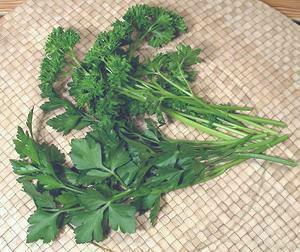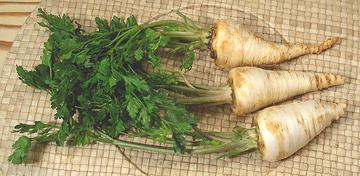 [Petroselinum crispum]
[Petroselinum crispum]
Leaves: Two forms are available, flat leaf (Italian) and curly leaf. Flat leaf parsley has a leafy texture, stronger, more complex flavor and is used in cooking. Curly leaf is used as a decorative garnish, having a texture similar to plastic and flavor to match. Like plastic it is very resistent to wilting which enhances its decorative usefulness. Dried parsley has little flavor so fresh parsley, now available year-round, should always be used, unless you are trying to accurately reconstruct recipes from the Eisenhower era.
Fruit (Parsley seed) The seeds are little used for culinary purposes except to grow parsley from. Getting it to sprout is not easy because its outer coating contains a substance that supresses sprouting. If grown in pots they should be deep to accomodate the tap root. The seed does find some use in the herbal supplement industry.
More on Parsley Family.
Parsley is used sparingly in American and European cooking, but is used in much larger quantity in the cooking of Turkey, North Africa, the Caucasus, and Central Asia, where recipes can call for a cup of chopped parsley.
Parsley should be crisp and not at all wilted. If just a trifle wilted
it can be refreshed by cutting off the bottom of the stems and setting in
a cup of cold water, perhaps acidulated with just a few grains of citric
acid. When recovered, trim the stems again and rake out any loose bits
or yellowed leaves. Wrap lightly and refrigerate.
 [Petroselinum crispum]
[Petroselinum crispum]
Root Parsley varieties have been developed that produce large tap roots
which are popular in cuisines of Central and Eastern Europe. The flavor
is more delicate and herbal and far less sweet than that of parsnips
so they are not at all interchangeable.